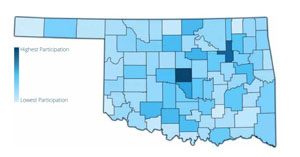Governor’s Biz Survey Results: What Surprised Us
-
Joe Wertz
Business is a big deal in Oklahoma, and political talking points hinge on discussions over what policies will bring new ones here, and what practices might help existing ones expand.
To that end, Gov. Mary Fallin and the Department of Commerce launched a website to survey Oklahoma employers about what’s hurting and helping business growth.
Much of it confirmed what’s already known and what’s regularly hyped by business leaders and lawmakers.
But a few things caught our eye.
Who Responded
Or, who didn’t.
While businesses from all 77 counties filled out the survey, some were much better represented. More than 46 percent of the 5,376 businesses that participated are located in Oklahoma and Tulsa County.

Most of the employers who responded to the 'Fallin for Business' survey of business executives were from populous counties.
Oklahoma and Tulsa County are economic centers and the state’s two most-populous counties, of course, so it makes sense that they’d be better represented.
Less populated, rural counties are poorly represented on the survey. For example, about .07 percent of the businesses surveyed were located in either Nowata or Coal County.
What Needs Improving
Business leaders were most worried about workers’ compensation costs, according to the survey.
And for all the attention the debate over Oklahoma’s personal income tax has generated, surveyed companies were more concerned about public funding sources and business incentive programs than “ business tax structure.”
Lowest Ranked Business Climate Factors
| Response | % rated poor or fair |
|---|---|
| Workers’ compensation costs | 84% |
| Access to sufficient public funding sources | 76% |
| Business incentives | 75% |
| Business assistance programs | 72% |
| Business tax structure | 72% |
Source: Fallin for Business Survey Report
Oklahomans Aren’t Skilled Enough
Twenty-five percent of businesses surveyed said it was difficult or very difficult to find skilled laborers, while 61 percent ranked the availability of skilled labor in Oklahoma as “fair” or “poor.”
In the next 3-5 years, most responding businesses said they’d need workers with more than a high school education.
But, according to the survey, workers with vocational certificates and licenses will be almost as needed as workers with bachelor’s degrees.
Also interesting: the expected need for workers with graduate/professional degrees was tied with the expected need for those with both associate degrees and high school diplomas.
Q: How will your need for employees in each educational category change in the next 3-5 years?
| Response | % increase |
|---|---|
| A bachelor’s degree | 24% |
| Vocational certification or license | 23% |
| GED/high school diploma: | 14% |
| Associate degree | 14% |
| Graduate/professional degree | 14% |
| No educational requirement | 04% |
Source: Fallin for Business Survey Report
Customers are More Challenging Than Employees
The biggest challenges, surveyed business leaders said, are all about the customer.
Customer loyalty was the No. 1 challenge facing business leaders, followed by increasing sales and managing corporate reputation.
In the report, the Oklahoma survey results were compared to a Conference Board survey of challenges CEOs in the United States faced in 2011. Business growth was a similar theme, but we found a couple of interesting differences:
Talent acquisition and retention — attracting and keeping the best employees — was the second-biggest challenge facing U.S. CEOs; innovation was No. 4.
Neither of those cracked the top five challenges Oklahoma business leaders said they face.
Keeping talented workers came in at No. 6, while attracting new talent ranked No. 13 on their list of challenges.
Innovation was No. 17


